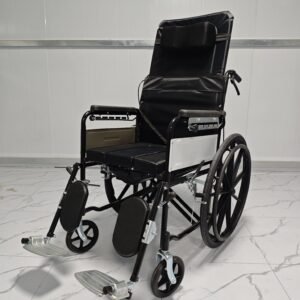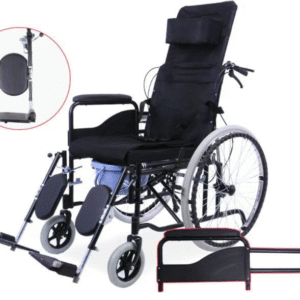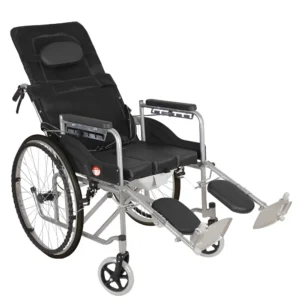Wheelchair for Disabled People: 6 Key Questions Answered—From Types to Sizing & Daily Use
For millions of disabled individuals, a wheelchair is far more than a mobility aid—it’s a bridge to independence, enabling access to work, social gatherings, and daily tasks that others take for granted. But with countless options available, finding the right wheelchair can feel overwhelming. Whether you’re a user, caregiver, or advocate, understanding the basics—from types to sizing—ensures the chair meets both practical needs and long-term comfort. Here are 6 critical questions answered.
1. What Are the Main Types of Wheelchairs for Disabled People, and How Do They Differ?
Wheelchairs are designed to match diverse disabilities and lifestyles. The three primary categories are:
Manual Wheelchairs: Powered by the user (via hand rims) or a caregiver (via push handles).
- Standard manual: Sturdy, affordable ( $300–$800), ideal for users with moderate mobility (e.g., post-surgery recovery).
- Lightweight manual: Lighter (25–35 lbs), foldable, great for frequent travel or users with limited upper-body strength.
- Reclining manual: Adjusts to 160° angles, perfect for users needing pressure relief (e.g., spinal cord injury patients)
Powered Wheelchairs: Battery-operated, for users unable to self-propel manually.
- Indoor: Compact, tight turning radius (30–36 inches), fits small homes or offices.
- Outdoor: Larger wheels, rugged tires, suitable for sidewalks or parks (great for users who enjoy outdoor activities).
- All-terrain: Reinforced frames, off-road tires, designed for uneven ground (e.g., trails, gravel).
Specialty Wheelchairs: Tailored to unique needs.
- Bariatric: Supports 300+ lbs with wider seats (22–24 inches).
- Pediatric: Smaller sizing (12–16 inch seats) for children with disabilities.
- Sports: Low-profile frames, lightweight materials (e.g., for wheelchair basketball or tennis).
2. How to Choose Based on Specific Disabilities?
The right wheelchair aligns with the user’s disability to maximize comfort and function:
- Spinal Cord Injuries: Prioritize reclining or tilting features to reduce pressure sores (common in users with limited sensation). A reclining wheelchair (140°–160° angles) redistributes weight, while anti-tip bars add safety.
- Mobility Impairments (e.g., arthritis, stroke): For users with weak upper bodies, a powered wheelchair with joystick control eases propulsion. Manual users may prefer lightweight models with ergonomic hand rims to reduce strain.
- Neurological Conditions (e.g., cerebral palsy, MS): Look for supportive seats (with lumbar cushions) and harnesses to maintain posture. Swivel seats simplify transfers, while smooth-rolling casters prevent sudden jerks.
3. Key Factors to Consider When Selecting a Wheelchair
Sizing: Ill-fitting wheelchairs cause pain or injury.
- Seat width: Measure the user’s hips (add 2 inches for comfort).
- Seat depth: Ensure 1–2 inches of space between the back of the knees and seat edge to avoid circulation issues.
- Seat height: 19–21 inches (standard) for easy transfers to chairs/toilets.
Features:
- Foldability: Critical for travel or small homes (look for one-handed folding).
- Weight capacity: Never exceed the limit (most manual models support 250–300 lbs; powered ones 300–500 lbs).
- Footrests/armrests: Removable or swing-away options simplify transfers.
Safety: Check for reliable brakes (lock securely on slopes), anti-tip bars, and sturdy frames (steel or aluminum).
4. How Wheelchairs Enhance Daily Independence
Wheelchairs transform accessibility, enabling users to:
- Navigate spaces: From home hallways to grocery stores, well-fitted wheelchairs fit through doorways (24+ inches wide) and maneuver around obstacles.
- Perform daily tasks: Reach cabinets (with extendable armrests), cook (with stable footrests), or work (with desk-height armrests for typing).
- Engage socially: Attend events, travel by public transit, or visit friends—powered wheelchairs with long battery life (10+ miles) support longer outings.
5. Maintenance & Care Tips
- Daily checks: Tighten loose screws (footrests, armrests) and ensure brakes lock properly.
- Cleaning: Wipe frames with mild soap to prevent rust; vacuum upholstery (mesh/vinyl) to remove debris.
- Tire care: Inflate pneumatic tires weekly (check pressure guidelines); replace solid tires if cracked.
- Battery upkeep (powered models): Charge after use (avoid full depletion) and replace every 2–3 years.
6. Budget-Friendly Options
Quality doesn’t always mean high cost:
- Entry-level manual wheelchairs: $300–$500 (e.g., standard steel-frame models from trusted brands like Drive Medical).
- Refurbished powered wheelchairs: Certified pre-owned models ( $1,000–$2,000) from reputable suppliers (check for 6-month warranties).
- Funding help: Many insurances cover wheelchairs with a doctor’s prescription; nonprofits like the Wheelchair Foundation offer free/low-cost options for low-income users.
Conclusion
A wheelchair for disabled people is more than equipment—it’s a tool for independence. By understanding types, sizing, and features, users and caregivers can choose a model that fits their needs, budget, and lifestyle, empowering fuller participation in daily life.
Thank you for reading this, dear, if you have any suggestions about our website or want to know about wheelchair, please contact us. We will respond quickly.



